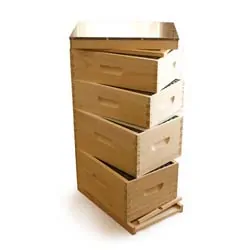What is the Small Hive Beetle
The small hive beetle is a common hive pest, particularly in southern areas. The winters in northern areas are a deterrent to them, while the sandy loam soils in the south are favorable for their maturation process.
At its adult stage, the small hive beetle is 5-7mm (.1967 – .2756in) long and has antennae resembling the head of a golf club. When they enter the hive, they are usually found toward the back along the bottom board and sometimes along the frames and running along the inner cover. The females lay their eggs in the protected nooks of the hive.
When the larvae hatch they feed on the pollen and honey. As they move around the hive, their defecation leaves a slimy mess which cause the honey to ferment. If the infestation is severe enough, the bees will abandon the hive.
Treatment
A strong hive is typically able to control the small hive beetle population on its own, negating the need for treatment. Weekly hive inspections are necessary to check the strength of the hive and for signs of uncontrollable infestation. Another preventative measure is to maintain a clean honey house and do not store full equipment.
Failing those options, if you prefer something more harmful to the small hive beetle, there are a couple of options: natural and chemical.
Natural
When the larvae have eaten their fill, they leave the hive and burrow into the soil beneath it to mature and continue the cycle discussed above. You can stop this cycle in its tracks by “booby-trapping” the soil with invective nematodes (Steinernematidae & Heterorhabditidae genera). When the larvae burrow into the soil, the nematodes burrow into larvae and vomit stomach bacteria into the larvae’s body cavity. These bacteria will turn the insides of the larvae into an icky rotten goo in just two days. The nematodes eat the goo and lay eggs. The cycle begins again and very quickly (the nematode cycle from infecting the larvae to new nematodes emerging takes only 48 hours) the small hive beetles are no longer a problem.
Chemical
Personally, I don’t advocate chemical treatments, but if it’s something you choose to pursue, there are only two chemicals that treat small hive beetle: CheckMite and GardStar.
CheckMite: to treat with CheckMite, cut the stip in half and staple it to a piece of corrugated plastic and slip it into the hive entrance face down. The the hive chases the beetles out, the beetles are trapped under the plastic and exposed the chemicals in the CheckMite strip.
GuardStar: treating with GuardStar may be less likely to contaminate wax and honey as it’s used outside the hive itself. To use GuardStar, mix it per the manufacturers instructions and spray in a 16” – 24” band around the hive. When the larvae leave the hive, they’re killed by the GuardStar, ending the small hive beetle life cycle.
Personally, I like the nematodes idea, but if you’re dealing with a small hive beetle infestation, the ultimate treatment is up to you.
References:

